Prefer to read in the language of Molière? 🇫🇷 C'est par ici !
TL;DR
- You can limit the impact of a paywall on SEO by altering your blocking method, however there's other factors to consider (such as bypassing and tech integration)
- Google is becoming increasingly more adapted to paywalled content, but there are still some key rules to follow, such as employing structured data for News and Discover
- It's ultimately about finding the balance between a successful subscription strategy and effective SEO, and we recommend taking it article-by-article, potentially employing different strategies across your site (we provide 3 options to reduce the risk of a paywall to SEO)
You’ve seen them. We’ve seen them. Readers have definitely seen them.
Walls are everywhere 😱
Paywalls, Registration Walls, Data Walls, and more...
It was only up until a few years ago that paywalls were reserved for online press looking to establish a more predictable, recurring revenue stream directly from their readers. Today, however, they’ve become much more popular.
Increasingly more content producers are starting to use them, from digital natives to e-learning platforms, broadcasters and even brands. The reason for this is simple: walls allow these content producers to turn anonymous audiences into leads, registered users and subscribers. They’re clearly hugely beneficial, and probably something that you're looking to employ (or already using).
There is, however, one concern that you might have...
Will blocking blocking content with a wall have an impact on SEO?
Generating revenue from content relies heavily on audience acquisition from search engines like Google... and, of course, SEO plays a vital role here. So, if employing a paywall will put this at risk, is it really a good idea?
You could argue that it’s like robbing Peter to pay Paul - we sacrifice the benefits of a paywall to have an effective SEO strategy, or vice versa.
But is this really the case?
It's an interesting (and important) question, one that forms the basis of this white paper - will a paywall have an impact on your SEO?
It's a tricky one to answer, but we work through the need-to-know, reaching the final conclusion that the question is less about sacrificing a wall for SEO or vice versa, but more about how you can limit the SEO risks whilst maximizing the value of a wall.
📺 Prefer to watch rather than read?
Catch the replay of our "Paywalls and SEO" webinar with Maxime Moné, Poool's CEO, and SEO expert Vahe Arabian to discover best practices and advice to maximize the value of both your conversion strategies and SEO performance.
- Paywall blocking methods, what impact do they have on content referencing?
- How to effectively reference on Google, including News and Discover
- Is it risky in the long term? How do you minimize risk and maximize success? What do the experts say?
- How to maximize both SEO and paywall performance simultaneously
- Real-life examples and the take aways
Part 1- Paywalls and blocking methods, what impact do they have on content referencing?
To be able to come to a useful conclusion in this white paper, we first have to understand:
- What a paywall is and what types can be employed
- What blocking methods are available
- What impact they have on SEO
If you’re familiar with this already, feel free to head straight to part two!
For everyone else, let’s go 👇
What are the different types of paywalls?
To make everything simpler, we’ll focus here on paywalls, but note that the main wall types can also apply to registration walls and cookie walls as well.
Freemium: Free content is available to all visitors to the site, whilst premium content is blocked by a paywall and requires a user to subscribe before gaining access.
Metered: In this instance, a paywall blocks all content (i.e. all content is subscriber-only content) but users are given access to a limited number of content for free in a given time period (per week or month for example). Due to unreliable cookie tracking, users are often able to bypass metered paywalls, so content producers who use this model generally also employ a registration wall as part of the user journey. A metered wall makes referencing a lot easier to deal with.
Hard: A hard paywall is when all content is premium and reserved for subscribers, The Financial Times being a famous example of this model.
Hybrid: A hybrid paywall combines freemium and metered methods, for example with exclusive content for subscribers, and a limited amount available for free every week or month. This model is the most popular one today. However, hybrid walls often don’t accurately reflect what content producers are trying to achieve.
Dynamic: As the Digital Media Review proved, there’s a current trend of blocking increasingly more content and restricting access to subscribers only . We’re also aware that the more pressure created by a paywall, the more likely it is that a part of your audience will leave the website (again, from the Digital Media Review). This encourages us to find a balance between engagement and frustration. A possible solution, which many publishers are adopting, is a dynamic paywall to adapt their wall strategy according to the user’s context or profile. Here, the objective is to maximize overall revenue per user. For example, you could adjust your wall strategy to the user’s level of engagement.
So, how does each wall type impact Google referencing? If you’re using a metered wall, referencing will be easier to deal with as Google will have easy access to content that you leave for visitors to access for free. If you have a freemium, hard, dynamic or hybrid paywall however, there will be a certain number of set rules to ensure Google properly references your content. We’ll come on to these later.
What are the different blocking methods?
Now that we’ve covered the different types of walls, it’s important to understand how content is blocked because it can directly impact SEO strategy.
There are three main ways of blocking content: User-side with CSS, user-side with Javascript and server-side.
“Frontal” or “user side” blocking methods: when you visit a web page, the content is there but it’s hidden and unavailable to the users. There are two main ‘’frontal’’ content blocking methods:
- Blocking content via CSS: the CSS method is generally the easiest to implement and causes the fewest side effects. The idea is hiding content with an overlay. The article’s <div> is hidden according to a predefined percentage and, when unblocked, the paywall and overlay disappear, making the content visible. With this method, all content remains on the page and can be seen when you scroll down.
- Blocking content via Javascript: this is basically the same as the CSS method. The content is hidden when a user doesn’t have access to it and shown when he does. The main difference is that the text doesn't actually stay on the page, it’s hidden by javascript, and the user doesn’t have access. This can lead to potential problems concerning advertising formats or editorial script-in conflicts.
‘’Back’’ or ‘’server side’’ blocking methods (without SEO optimization): Differently to frontal blocking, and as the name suggests, blocking occurs on the server side. This means that the content as a whole is never sent to the page. In most cases, there are 2 pages on the server side: a full page and a cropped one. The cropped page is sent by default and, when the user gets the rights to access the content, a full page is sent. This blocking method, as you’ll see later, is safer but also more complex to implement. Furthermore, if it’s not properly used, it can have the greatest impact on SEO because none of the content, aside from the title, is available on the page.
For a server side block, if nothing is done, users (and Google) will only see the header, and so only that part will be referenced.
‘’Back’’ or ‘’server side’’ blocking methods (with SEO optimization): this works in the same way as the previous method concerning content blocking. The only difference is that content is available to the Google Bot, either by allowing it through the paywall or via a structured data method. Le Monde has tested out this method (which is no longer live) - the idea was to display the whole page for the Google Bot, but show your audience a cropped and inaccessible version.
Unfortunately, it was still possible to get around it, which is probably why they stopped. If you display a full page on the server side, your content will be more easily accessible. In such a case, there are paywall bypass extensions such as “Bypass Paywalls” that use every known method to get around a paywall.
Pros and cons of each method:
The expert’s opinion: Simon Gleize - SEO consultant:
‘’If you have to remember only one rule to reference your content blocked by a wall, it’s this one: that the content be made available to Google without it looking like cloaking.’’
So, what’s the solution? A user or server side block?
Well, you might be disappointed, but there isn’t a single answer. It highly depends on your business model and strategy:
- Does your business model have a 10% or 90% reliance on indirect revenue?
- Is subscription strategy an essential part of your strategy?
- Is your audience likely to know how to bypass a paywall?
To give you some clarity, here are some guidelines:
You may use a front blocking method (at least at the beginning) if:
- You rely heavily on ad-revenue
- Your audience isn’t likely to know how to bypass paywalls
- You have doubts on the impact of a server side method on SEO
- You’re launching a paywall/registration wall strategy and want to run a few tests
You may prefer a server side method if :
- You have a good understanding what SEO implies
- You have a lot at stake concerning security and content protection
- Your audience knows how to bypass your walls
The expert’s opinion: Alexandre Santini - CPO at Poool:
‘’Editors have a tendency to protect front side blocking, as time has shown that a majority of users don’t try to ignore. We also know that those who look for flaws don’t convert. For me, server side blocking should be correlated to business questions (expensive subscription for example)’’, or audience (e.g. if the title relates to cybersecurity) or image."
Bonus: a (short) summary of methods to bypass paywalls
As a bonus, we’ve put together a list of ways to bypass a paywall.
‘’Manual’’ bypass: requires an action from the user on the web page, either deleting an element/function (e.g. javascript) or checking the computer code. For example:
- Deleting the CSS
- Altering the CSS (see: Le Parisien)
- Deleting the javascript
- Checking the page source code
- Accessing the Google cache (for text versions) if there is no noarchive tag
(Find out more here)
Ways to bypass using web extensions available on browsers: In this case, there are extensions/features inherent to browsers. Most of these will scrap the HTML and therefore delete CSS or JS elements from the web page to create a ‘’zen’’ reading mode. For example:
- Zen mode on Safari and Firefox F9
- Web extensions like Mercury Reader
Ways to bypass using web extensions not available on browsers: There are some paywall bypass technologies that aren’t referenced on extension stores but are available on Github (for example) and can work in developer mode. For instance:
- Bypass Paywalls
- Unpaywall
The people who develop such methods are usually very tech savvy and can upgrade their tools with feedback from their community.
How to bypass walls using ad blockers: this is a very technical topic. A paywall can be blocked by an adblocker in two distinct cases:
- The paywall solution’s (partner) script is blocked by a list of ad-blockers (Ablock+, uBlock, …) or by a privacy list such as Disconnect (used by Firefox). If the script is blocked, the paywall won’t appear.
- Adblocker lists can block a paywall prompted by a tag manager. Google Tag Manager (GTM) is, for example, blocked by uBlock. Therefore, if the script is called upon through the GTM, the script call will be blocked and the paywall won’t appear.
Users are able to get around my wall, is that an issue? 😱😱😱
The New York Times, for example, uses javascript user-side blocking methods. This is interesting given that it’s very easy to bypass and a number of users succeed in getting past their paywall.
We can’t be entirely sure why the NYT uses this method (given the size and value of their business) but there are 3 potential reasons:
- User side methods offer a lot of flexibility
- There’s very little risk or impact on SEO
- Perhaps most importantly because users that bypass The New York Times paywall aren’t the main target. These users aren’t likely to subscribe on a short or medium term basis
As the NYT results show, you may have to accept that there will be a certain amount of paywall bypass but that this won’t affect digital subscriber growth.
Find out more in our dedicated article:

Part 2 - How to effectively reference on Google, including News and Discover
Now that we’ve got a better understanding of blocking methods and how they impact referencing, let’s turn to look at the main issue at hand: Can walls have a negative impact on SEO, whether we use ‘SEO friendly’ blocking methods or not?
Firstly, and unfortunately you won’t find a definitive answer in the next few lines, simply because there isn’t one.
We’re not able to understand all the variables that go into SEO, so it’s therefore hard to accurately predict the long term impact of a paywall on a SEO strategy. However (stay with us!), the next few lines should allow you to make up your own opinion and help you to minimize any risks involved whilst maximizing wall success.
What’s Google’s view on premium content (now and before)?
To understand the long-term risks of walls on SEO, we need to understand Google’s (often complicated) views.
When walls started to grow in importance among publishers , Google had to give its opinion. Since then, just as walls and their use have evolved, so has Google’s opinion:
2005: First Click Free. In 2005, Google introduced the First Click free concept, which would allow a Google Search user to access any content for free, even if it was premium and blocked by a wall. In doing this, Google’s objective was to give publishers the opportunity to be discovered in Google News and Google Search. They’ve explained this in their blog:
“The spirit of the First Click Free effort was, and still is, to help users get access to high quality news with minimal effort , while also ensuring that publishers with a paid subscription model get discovered in Google Search and via Google News.”
2009: First Click Free restricted to 5 articles. In 2009, subscriber-only models were catching on and editors feared that users were taking excessive advantage of the “first click free” initiative. SEO is as important to publishers as the content they provide is to Google. Google adapted and, after an update, restricted the first click free to 5 articles.
2015: First Click Free restricted to 3 articles. By 2015, there were more ‘’big’’ american publishers that used paywalls than those who didn't. It was also at this stage when paywalls and digital subscription strategies started spreading to other countries. Accessing paid-for content became a crucial concept and, naturally, Google took the limit down to 3 articles.
2017 : Goodbye First Click Free. Hello Flexible Sampling. Fast forward to 2017, and Google announces that they’re going to end the First Free Click feature. This was released in an article written by Richard Gingras, VP of News at Google, named “Driving the future of digital subscriptions” which highlights the change of tone and direction. Now, Google are no longer able to decide how many articles should be free for users , publishers will need to determine what that number should be:
“We will end our First Click Free policy in favor of a Flexible Sampling model where publishers will decide how many, if any, free articles they want to provide to potential subscribers based on their own business strategies. This move is informed by our own research, publisher feedback, and months-long experiments with the New York Times and the Financial Times, both of which operate successful subscription services.”
The key sentence here is that “publishers will decide how many, if any, free articles”. With flexible sampling, making some articles free could become confusing. Even if Google strongly recommends making some content free, it’s not mandatory.
In fact, on their blog, Google explains that there are 2 Flexible Sampling models:
- Metered: which allows a user to access a certain number of articles for free before a paywall is presented and they have to subscribe
- Lead in: which allows the user to access the first few lines of an article, whilst the rest is blocked and they have to subscribe to continue reading.
So, given this evolution, how do you properly reference blocked content on Google?
As we’ve seen, you should use one of the flexible sampling methods, either metered or lead-in, to reference premium content on Google.
There are a few rules you need to remember, and they differ according to the format: Search, AMP, Google News + Discover.
What about putting up a paywall for Search content?
As well as choosing a blocking method, and Google’s rules on content blocked by walls, there are more guidelines for referencing content, specifically ones regarding cloaking.
The expert’s opinion: Simon Gleize, SEO consultant: ‘’If you have to remember only one rule to reference your content blocked by a wall, it’s this one: that the content be made available to Google without it looking like cloaking.’’
(PS: we loved Simon’s quote so much, we just had to put it in twice.)
What is cloaking?
An issue with content being hidden behind walls is that it can be considered cloaking. The practice known as ‘’cloaking’’ consists of showing users a URL that isn’t the same as the search engine URL. This breaches Google’s webmaster rules, as it doesn’t give users the search result they were expecting. This could be the case for blocked or premium content: with lead-in flexible sampling, the content shown to the user is cropped, and the content shown to the Googlebot can be available in full.
To solve this problem, Google suggests using structured data and following these 3 steps:
1) Add a class name to each section of the page that’s blocked by a paywall.
2) Add some NewsArticle structured data.
3) Add the structural data linked to the paywall in the JSON-LD NewsArticle.
Note: JSON-LD and the microdata represents the accepted methods for structured data redaction for content behind a wall.
All of this is explained clearly in an article on Google documentation.
Once the data is structured, you have 2 options:
- Only reference the article section accessible via the ‘’lead in’’. In this case, you don’t need to do anything.
- Reference the whole article, even the paywall section. In this case, you should check if your page is indexed by Googlebot.
If you pick option number 2, your content referencing will also depend on what content blocking method you’ve chosen:.
- Front side/user side blocking method in CSS or Javascript: you don’t need to do anything as the content is already available on the page
- Server side blocking method: take a look back at part 1 of this paper to see how you can optimize referencing with this blocking method
Finally, you’ll have to make sure the content can be indexed and analyzed by Google (no blocking Googlebot or Googlebot-News in the robots.txt file).
The expert’s opinion: Julien Picot - Technical SEO Lead for Oncrawl: to guarantee blocked content referencing, the important thing is to let Google see all of your content, including what’s on the page and behind the paywall. By having access to all content, Google will be able to determine whether the page is relevant to a given subject. With all the structured data, you’re signalling to Google what part of the content is available to everybody, and what is behind the paywall. This is important, as Google can sometimes confuse this with cloaking. Finally, to ensure that a crawler sees your website like Google does, you should white-list your crawler’s IP.
What about putting up a paywall for AMP content?
AMP stands for ‘’Accelerated Mobile Pages’’. It’s a technology developed by Google to access content faster on mobile devices.
Most of the time, you’ll find this format on mobiles when you search via Google. In the first few results, you’ll see website ‘’cards’’ and can swipe through to see other cards from a variety of sites. It’s used in other situations, but this is the most common.
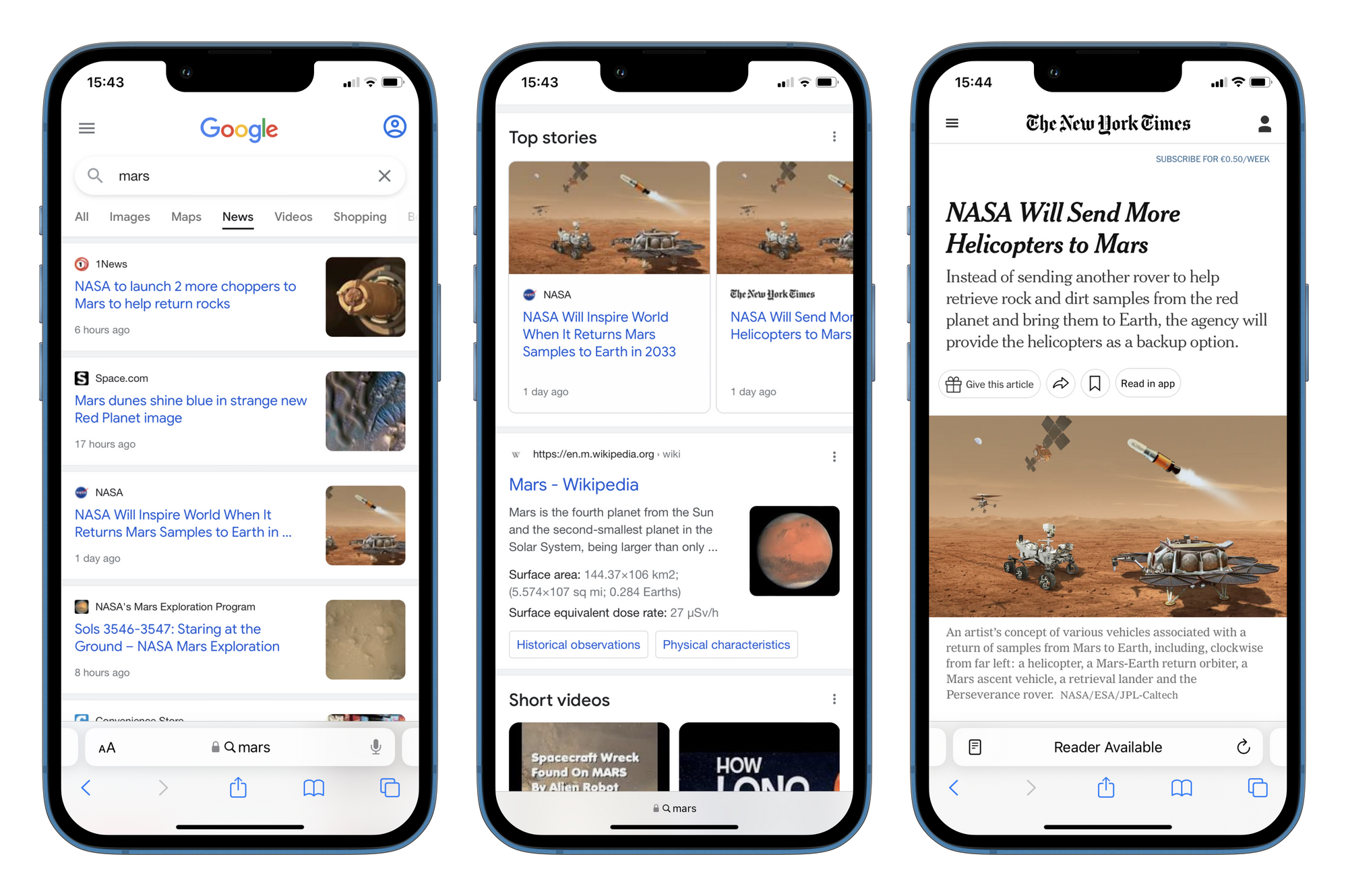
Some good news for you - It’s entirely possible to put up a paywall for AMP content, making some content exclusive to registered members or subscribers. To do this, you’ll have to use the AMP-Access to manage what content you want to block.
At Poool, we’ve developed our own way of managing access to content. Poool’s dynamic paywall for AMP content producers is called AMP-Access-Poool.
If you do decide to publish your content on AMP, here are a few guidelines to follow, as advised by Google:
- ‘’Make sure your authorization termination point lets Google and other robots access content. Each editor has their method.’’
- ‘’Make sure the access rule you have for robots is the same for AMP and standard pages. If you don’t, you may get error messages such as ‘Content doesn’t match’ in the Search Console.’’
The editor’s advice: Alexy Souciet - SEO Manager - CMI France: If you release a premium version on desktop, be ready to release a premium version on your AMP (if you have one). If you don’t, you may encounter 2 problems:
- Your content will be blocked on the desktop version but available for free on the AMP. The coherence of such a model would be questionable.
- Let’s say your content is blocked on desktop, but you’re not ready to do the same on AMP, so you decide to ‘disable’ your AMP content. In this case, there’s a risk of losing AMP traffic, which isn’t constantly offset by desktop traffic. If you quickly reactivate your premium content on AMP, you’ll likely get the same traffic flow back.
What about putting up a paywall on content recovery by Google News?
That’s an interesting question and one we hear a lot. The answer seems to be that it is indeed possible.
If you follow the previous guidelines, provided in the ‘’Reference premium content for Google Search’’ section, you should be able to reference your content on Google News. The only difference being that you’ll have to adjust the different rules used for Googlebot-News as well as Googlebot.
What about putting up a paywall on content recovery by Discover?
First of all, what is Discover? Google Discover is a personalized news feed with a simple objective: ‘’Discover new information and inspiration with Search, no query required” (as explained by Google). It was actually created in 2016, rebranded, and is now on several Google apps and products, more or less natively (the Google app, Google Chrome, natively on some Android phones…).
It’s easy to understand the strengths of such a tool, as so many users natively accept it without necessarily having wanted it. It’s an amazing source of traffic, and helps reach a new audience. Since mid-2019, a ‘’Discover’’ tag has been featured on the Google Search Console, showing the potential of this feature.
Just like with Google News, you might wonder how to properly reference premium content on Discover, if it’s even possible and what the rules are that you have to follow.
The expert’s opinion - Simon Gleize: SEO consultant: ‘’There are no clearly established rules guaranteeing that an article will appear on Google News or Discover. But we’re seeing more and more paywalled articles being picked up. In fact, Google’s recent evolutions (Google News Showcase, Subscribe with Google...) are a clear sign that they’re starting to notice the shift in press economic models online, naturally turning towards subscriptions."
Despite the fact that there are no ‘official’ rules, some SEO specialists still give advice on good business practices to help you boost your chances of appearing in the first few results.
The editor’s advice: Alexy Souciet - SEO Manager - CMI France: ‘’For Elle.fr, making the content from our ‘’hot’’ strategy premium didn’t hinder visibility on the News box, Google News or Discover.
We use a front blocking method, with no HTML/JSON tag declaration, found in the Google guidelines.’’
At this stage, you might wonder what the best wall strategy is for these platforms (News, Discover) and on which audiences. Poool’s dynamic paywall solution would solve those problems: you can adapt your strategy to the user’s context and employ different walls for different types of content, e.g. use a Registration Wall for AMP content, or a free 24h trial. Book a free demo here!
Part 3 - Is it risky in the long term? How do you minimize risk and maximize success? What do the experts say?
Even if you do follow all of Google’s recommendations, how can you be sure that a Paywall won’t have a negative impact on SEO in the medium-long term?
As you may have understood, it’s possible to have a content blocking strategy (Paywall, Registration Wall…) and limit SEO impact in the short term. You can monitor what Google ‘’sees’’ and therefore optimize this section of your content.
However, if, in the near future, you decide to block more and more content on your website, how will your audience’s behavior impact referencing your premium content?
The Digital Media Review has shown us that, for publishers with premium models, having content that is highly visible positively impacts conversion rates (up to a certain point), BUT that it has a negative impact on the number of users who leave the website when presented with a wall.
After learning this, an SEO manager might have several questions:
- How will SEO be affected if we have a large amount of premium content on our site and the exit rate skyrockets for users faced with a wall?
- For the same reasons, could backlinking be less important on premium content than on free content?
And the questions could go on. This begs the question: Do walls have a negative impact on SEO in the long term?
Let’s look at some examples.
The New York Times, who’ve had a subscription strategy for over 10 years, also have a high level of user frustration (register wall on the 2nd article, sometimes even the first, and a paywall later).
Despite this, they still manage to reference in the long term, as shown by their results:
- Top 50 in the US
- Top 100 in the world
- And 32.75% of their traffic comes from Search
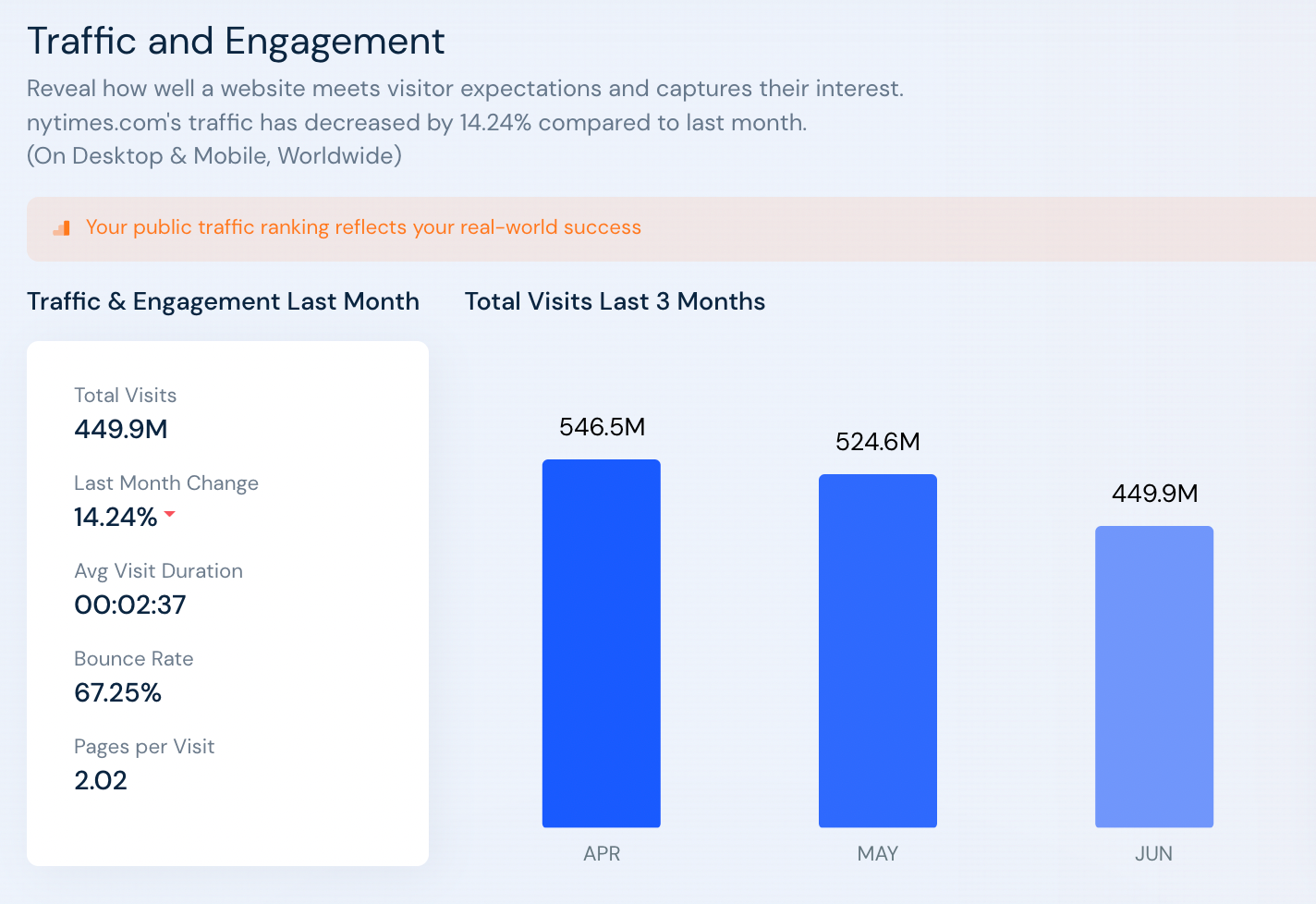
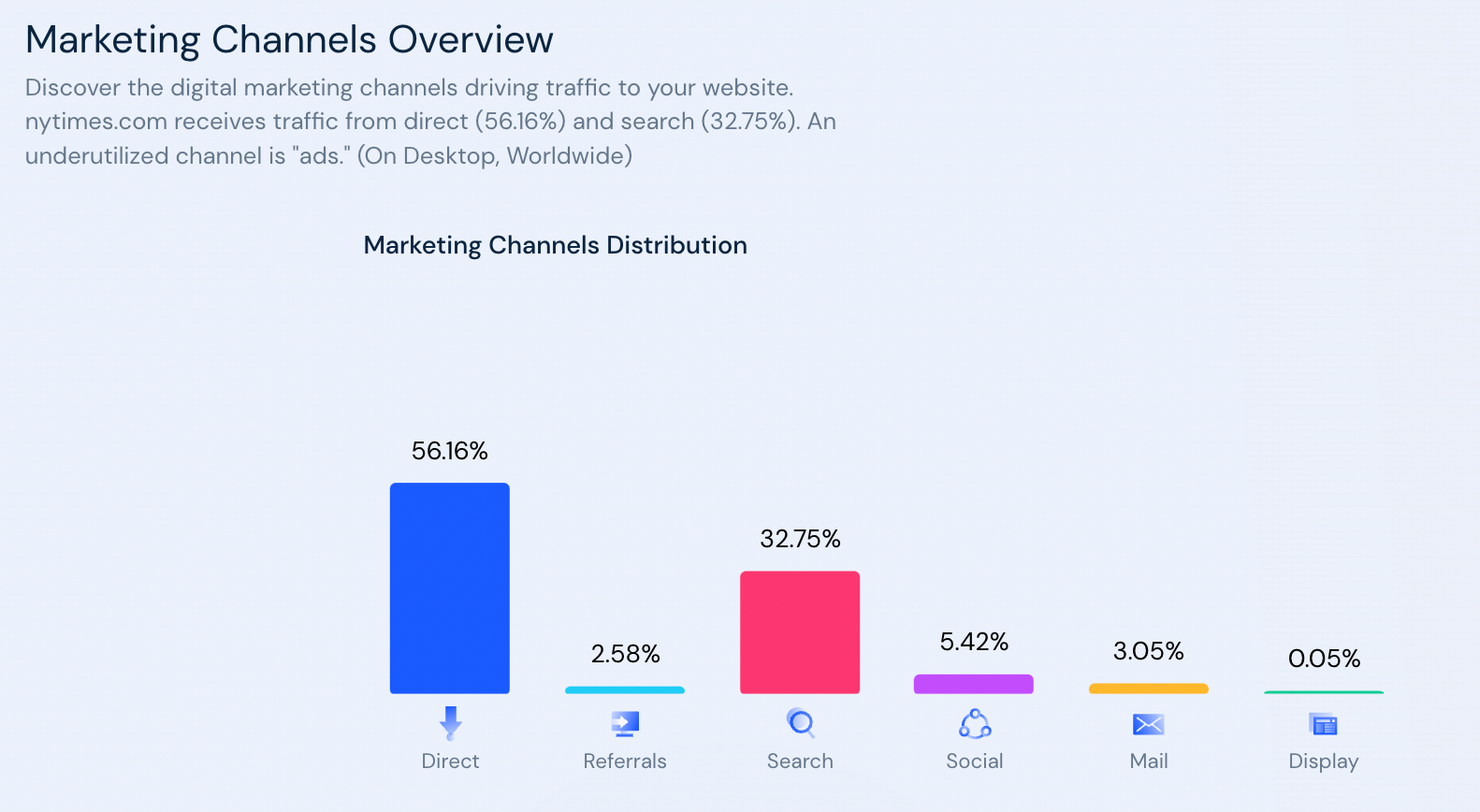
Note: be careful with these numbers, as there’s quite a lot of uncertainty around what percentage of traffic comes from search:
- The percentage of ‘disguised’ direct access (‘’NYT’’ or ‘’New York Times’’ searches on the search engine)
- The percentage of traffic linked to specific pages or articles
- How this has evolved in the past 20 years
And it gets more complicated as we delve further into it. Editors’ experiences with a wall and SEO usually differ.
Dan Smullen, SEO manager for Independent News & Media, has run several tests to measure the impact of Paywalls on content referencing (this example is available in an article on the CXL blog).
- 1st test - set up a Registration Wall.
‘’Before launching a Paywall in February, we implemented a soft wall (a Registration Wall). We tested this on two temporary replicas of our sites in Canada (independent.ie/ca/) and Australia (independent.ie/au/). For users in those countries, we put all content behind a registration wall. The result was that we saw less than a 5% drop in traffic over a six-month period but a considerable amount of new registrations.”
- 2nd test - set up a paywall on well referenced, evergreen content.
“We also tested putting 50% of travel content (with an average position of 1–5 in Google Search Console over a 3-month period) behind a registration wall. The travel section on Independent.ie was selected due to its ranking for evergreen queries, such as “things to do in Canada.” We saw no significant decrease in average ranking. Currently, Independent.ie is still #1 on Google.ie in Ireland, despite being behind a paywall.”
Overall, little to no impact on SEO, and a very positive impact on business.
But Barry Adams, SEO expert at Polemic Digital, gives a more nuanced response:
“If Google has to choose between gated content and free content that have roughly the same quality signals, Google is always going to rank the free content first because it provides a better user experience.”
Two interesting opinions.
We also need to add in the fact that Google can’t block a trend among publishers, namely that walls and premium models are becoming more and more popular. If free content is favored by the Google algorithm, what’s presented to users in search results will become less and less relevant.
As you know by now, you won’t get a definitive answer to the ‘’is setting up a wall risky for my SEO’’ question, here or anywhere else.
So, because we won’t get an answer, we should change the angle of the question. After all, publishers who set up wall strategies do it for a specific reason. Namely to expand their membership base, acquire new digital subscribers, etc.. There is business logic here, it’s not just for fun.
We may then want to ask ourselves how can we limit the SEO risks while maximizing the value created by walls?
Possibility 1 - Limit a wall’s SEO impact by adapting the blocking method according to content-type.
As we’ve seen in part 1, the choice of blocking method (user side or server side) and the type or paywall (metered or hard) can impact your SEO.
So, rather than finding a method that applies to all types of content, some editors try to take the best elements from each method. This is the case of one of our clients, Gamekult. Their approach is to use a hybrid freemium-metered paywall with 2 content blocking methods. Server side blocking for exclusive content, and front side blocking via a metered wall for high SEO risk content.
Possibility 2 - Limit the impact of a wall on SEO by adapting the strategy to new vs existing content
New content: I’m setting up a wall for a new type of content
If you want to position yourself on Google with content where the competition is fierce and in a subject area where you have no experience, we wouldn’t really recommend immediately placing all content behind a paywall. This is not only because of your SEO risks (like we’ve discussed) but perhaps also because, if you’re entering a new topic area, why should your audience subscribe if they aren’t yet sure of your level of expertise in that subject?
However, if you do choose to put up a wall straightaway on this type of content, we have some advice:
- Follow all of the Google guidelines from this white paper
- Follow and monitor the percentage of content that’s hidden behind walls
- Keep testing! For example, try blocking just some of your content at first and leave other content available, just like the Independent News & Media group (we’ll come back to this later)
Similarly, if you want to import some print content to digital and make it premium, you should check for existing, well-referenced content on the same topic, otherwise it could have a negative impact on your page’s visibility on Google.
Existing content: I’m launching a wall on some already existing content
In this case, be careful with ‘’cold’’ content (even more so if your rivals are already positioned on that topic organically).
With this existing content, it’s likely that you’ll have invested heavily in its positioning on google. However, integrating a wall could negatively impact this, in the medium and long term. If this does happen, it might take a while for you to get back to your original position.
Publishers have told us in the past that putting up a wall for such content has caused losses, despite a stable visibility in previous years. On the other hand, if you put up a wall for your ‘’hot’’ content, for which your competition also uses paywalls, the risk is much smaller.
So, “is launching a paywall risky for my SEO?’’ Well, we can tell you this much: In some cases it is, but if there is a risk, you can minimize it while maximizing your wall strategy’s chances of success (account creation, subscription). The goal is to think about every angle, including both SEO and your wall strategy.
Possibility 3 - Limit the impact of a wall on SEO by adjusting your strategy according to SEO risk
This is a question of arbitrage.
For example, When you look at most publisher’s overall objectives, you’ll see:
- Bring in more users
- Engage them
- Monetize them
- Collect data
- Turn users into members or subscribers
- Retain them and limit churn
Some users will help you attain these goals, but not all of them. In the same way, each content has its own purpose and will achieve a different goal to another piece of content. It’s a balance between each goal. So, you should find a balance between optimizing a wall strategy and optimizing an SEO strategy.
A few months ago, our consultancy team designed a flow chart to help publishers select what content should be premium, and which should be free (obviously every publisher is different and should adapt to their own content but this is a useful guide).
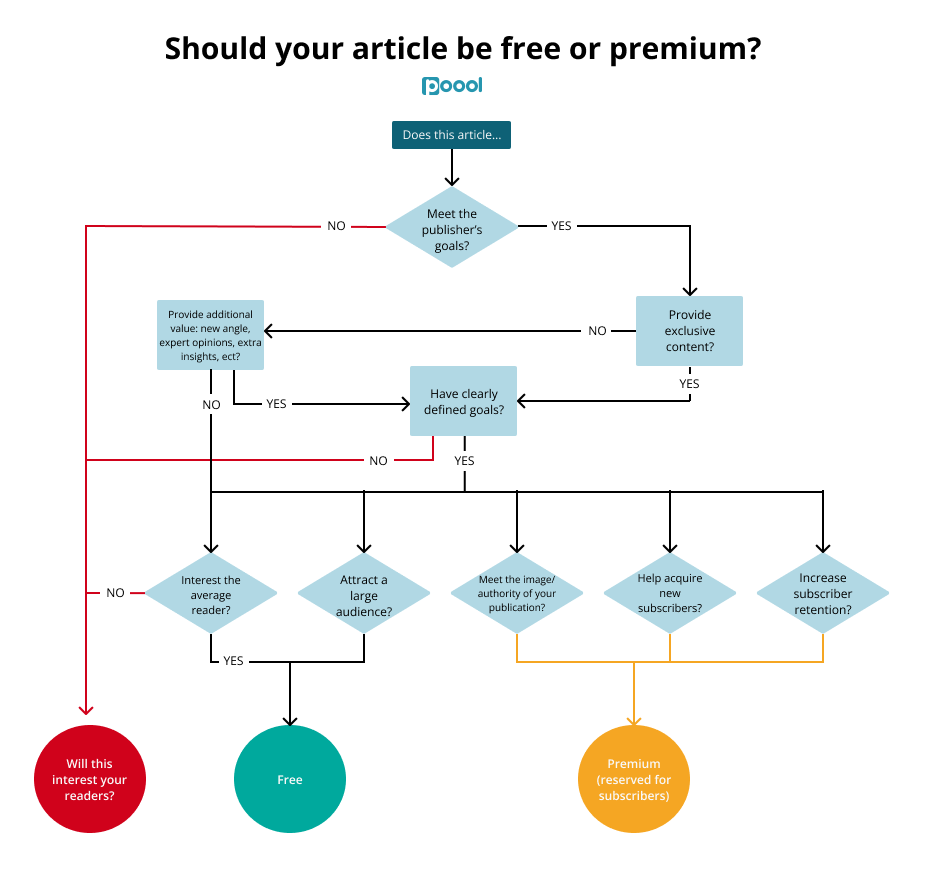
While writing this white paper, and talking to SEO experts, we realized that this diagram could be adapted to a publisher’s SEO challenges. Before deciding to make any content premium, you’ll need to look at a couple of things, other than the above:
- Is the SEO risk low, medium or high?
- To what extent is making this content premium likely to achieve business goals (engage, retain, transform)?
You can then use this to decide if it should be premium or not:
- If your content has a low SEO risk (e.g. hot content, competitors have a wall) and is likely to help you to attain your objectives, nothing points against going premium
- But, if it’s not likely to help achieve business goals and the risk to SEO is high (e.g. evergreen content, competition is free), you should probably think twice about putting up a wall
The experts’ opinion
We wanted to shed light on the subject by interviewing experts and asking them about good business practices for wall deployment strategy and ways to limit the risks on SEO.
Alexy Souciet, SEO manager at CMI France
The editor’s advice:
"I used to agree with this. For a ‘’cold’’ strategy, with high volumes of search requests, even more so in a ‘’free’’ competition context, you immediately think that adding a paywall will ruin your chances. That's because the ‘’frustration’’ created by the paywall, for equal optimization levels (editorial, linking, techniques) could work against you, in particular concerning UX signals. Empirically, there could be differences."
Some advice to limit the impact of SEO:
"Don’t switch a large existing inventory to premium for the SEO audience. At first, for production, have a mind map for the free/premium arbitrage and add the SEO dimension (and the potential traffic notion). Be careful not to only leave ‘’the crumbs’’ to the premium content - work towards a SEO and premium combination. Do it progressively, step by step in test & learn
What to watch out for:
"When you’re juggling 2 monetization models, the traditional ‘ad’ and ‘premium’, you should monitor content cannibalization, new journalistic writing practices, internal linking, headings and semantic optimizations - these could all undermine the SEO work you’re doing."
To conclude, an anecdote about an unexpected behavior.
"Here is some content tailored to perform well in SERPS, but hidden by a paywall. Most of its competition is free, and it still appears in the “0 position”. Because in this situation Google “sees” all of the content, it has no problem extracting information to add to its excerpt. Here we have become the victims of our own strategy…"
François Chauvin, Head of acquisition B2C at Welcome to the Jungle
How do you prevent risk?
"Google’s recommendations on the matter are very clear, and if you follow each step you won’t have to worry about any kind of penalty. You could, justifiably, think that Google didn’t simply inspect a portion of the article hidden behind the paywall. Google specifically described some guidelines for the schema.orgJSON-LP method, in order to avoid any loss of positioning. Putting in place some simple and specific structured data (NewsArticle, isAccessibleForFree…) will allow you to properly notify Google about your strategy and not lose any of your articles’ positioning. However, you’ll need to keep a close eye on the user experience for these articles to determine whether this experience has been damaged or not, and if it might have an impact on medium term SEO visibility, user satisfaction, and content quality."
What tools are there to monitor impact?
First and foremost, you should define the main KPI you want to monitor, as well as the secondary ones. I think it’s crucial to be able to precisely compare all UX indicators, including bounce rate, time spent on the website, page views per session, etc. , to analyze the impact of integrating a paywall on your user experience. You’ll also need to compare your user behavior according to where they came from (Google, social media, newsletter) to figure out if some layouts, messages or other actions can lead to better results. It’s also primordial to determine the revenue generated by a member vs a non-member (additional visits and seen pages, additional subscriptions to partner services, job applications,...etc).
Part 4 - How to maximize both SEO and paywall performance simultaneously
You’re an editor and you want to launch a paywall, register wall or cookie wall model? Adopt a step-by-step strategy. It might not guarantee 0 risk, but it will limit the impact on SEO whilst maximizing your chances of building a successful wall.
1 - Choosing what content to put behind a wall
First of all, you’ll need to decide which content will be premium and which will be free. For each, ask whether they present a risk to SEO.
- Is the risk to SEO low, medium or high?
- Is the impact on your business strategies (engage, convert, retain) low, medium or high?
If there is high risk and low business impact, you should probably keep it away from wall strategy (go back to the previous section for more info:)).
2 - Choosing the right blocking method
As we covered in part 2, the choice of blocking method is specific to each publisher. However, except for very specific cases, you should favor a front side blocking method.
There are 4 reasons to this:
- It’s easier to implement
- It’s more SEO friendly than a server side blocking method (with no technical optimization needed)
- Except for some specific cases, the risk of possible bypassing is weak
If you block the user side, but you estimate the risk to be high, switch to a server side method. This makes more sense than the opposite option, where you’ll see big developments and in the end come back to something more basic.
Our number 1 argument though is that the New York Times uses a front side blocking method, probably for the reasons we’ve explained previously, so it’s clearly a pretty successful blocking method!
Note that you could also use a hybrid model like our client, Gamekult (i.e. some high value content blocked on the server side and other content, with less value, added on the front side).
3 - Follow Google’s instructions and test that everything is OK
You should read part 2, an explanation of how to properly reference in all different Google ‘’environments’’: AMP, News, Discover...
Once you’ve understood all this and implemented all the proper rules, you should check if Google is properly implementing its guidelines. To do so, you have 2 tools:
- The Google Search Console and the URL inspection tool
- Google’s Structured Data Testing Tool
4 - Run tests to limit risk
If you decide to launch a wall on your website, and you have doubts about the impact it will have on your SEO or about the choice of blocking methods… run tests!
To start with, set up the wall on some content, or on one content category.Then, find out if it’s referenced on Google, importantly if it’s well referenced, in order to see if the wall impacts your positioning.
Part 5 - Real-life examples and the take aways
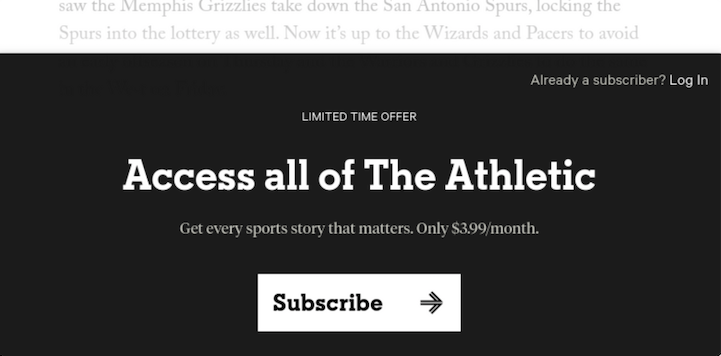
Type of paywall: Freemium
Blocking method: server side with complete content sent for Googlebot
The Athletic used to employ a hard wall strategy, but they now take a freemium approach to broaden their audience and get into profitability. Now, they successfully drive people to convert through CTA buttons on their pillar pages whilst specific topic 'cluster' articles have lead in paywalls to increase subscriptions.


We can say then that a different strategy may be used depending on the paywall employed and content, but also on where the maturity level of the publisher (i.e. at the start of their subscription strategy, employed a paywall for years, etc).
Type of paywall: Metered
Blocking method: user side (content is available on the page)
Metering is a great approach for allowing non-subscribed readers to discover your premium content whilst also encouraging conversion. It also works well for SEO as all content is available to Google bots.
Type of paywall: Hardwall
Blocking method: server side where the whole content is sent to Googlebot
Type of wall: Metered
Blocking method: user side (JS)
Type of wall: freemium
Blocking method: server side with complete content sent to Googlebot
Conclusion and take aways
So, "is it possible to launch a wall (Paywall, Registration Wall, Cookie Wall) without impacting your SEO?’’
As you’ve seen in this white paper, we can’t say for certain that you can launch a wall strategy without impacting your SEO.
Some think it is, others don’t.
🤯🤯🤯
Because we’ll never get a 100% reliable answer, we should look at the question from another angle: how should we combine a wall and SEO strategy?
This was the message we wanted to convey with this white paper, a better understanding of what’s at stake, and then implementing a strategy that will suit your needs and whatever risks you may encounter.
If you’re launching a wall, you probably have a very specific objective in mind:
- Bringing in new subscribers
- Optimizing consent rates
- Etc…
...and launching a wall might lead to some objectives being positively impacted whilst others aren’t, such as ad revenue.
You have to ask yourself if launching a wall helps you bring in more revenue globally, whether the goods outweigh the bads. And whether the SEO is impacted.
If you marginally impact SEO but considerably increase revenue, you’ve succeeded and your only issue will be to control the wall’s impact on SEO.
This might seem simple, but knowing whether‘’putting up a wall helps to increase revenue globally’’ is far from easy. We need a holistic view of revenue, not to simply compare advertising and subscription, SEO and direct access. We need to truly think global. Think in terms of revenue per user.
All this seems like it’s very far ahead of us, but it’ll be the norm in the next few years, with the Chief Revenue Officer who’ll start to enter companies.
To go further, check out our webinar conversation with SEO expert Vahe on the same subject:



